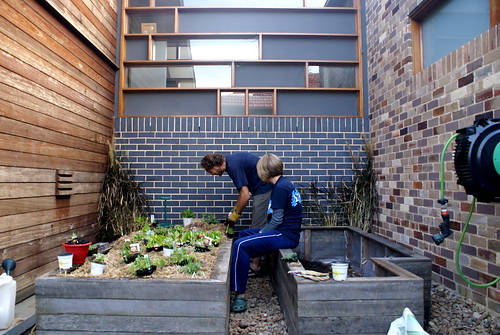

This is the best gardening choice for those who have no yard space or backyard. Even if your available lawn space was weedy, packed with hard clay, full of stones, or made of concrete—your vegetable garden will still be easy to build.
The first thing to do is to find for a place. And you chose the front lawn as the future site of your vegetable garden. Just make sure that this spot receives 5 hours or more of sun every day.
Next, gather your materials. With the use of your bare hands and some extra help from the family, collect the following:
1. old cardboards, boxes, old wool carpet, jute sacks, pieces of wood or plywood;
2. broken branches, logs, old planks of wood, loose bricks or rocks; and
3. washed seaweeds, tree barks, fallen leaves, hay or alfalfa, loose straw or cut grasses.
These items have to be bought from the plant nursery or other sources:
1. vegetable seeds and black seedling bags; and
2. commercial fertilizer or organic fertilizer such as well-composted manure from chicken, horse, cow or sheep.
You can compost your own organic fertilizer from kitchen wastes. You can create your own seedling bags from old newspapers.
The whole process of laying out your vegetable garden takes only one morning, if you have all the materials on hand.
Procedure:
1. Measure the size of your plot. The length could be as long as your lawn, but the width should not be wider than one meter. Put about 10-inch or more high ‘fence’ made of logs, branches, planks, bricks or rocks. The idea is to raise the garden plot from the ground.
2. Even the ground. Remove humps or fill up gaps with sand or soil. Place the first layer, consisting of old cardboards, jutes, non-synthetic old carpet, and old plywood.
3. Spread the pre-soaked newspapers to fully cover the first layer. The pages should overlap so that no ray of sunlight can slip underneath where stray weed seeds may grow.
4. Lay a 5-inch high of straw, hay or alfalfa, grasses, leaves, barks and seaweeds (thoroughly washed to remove salt). Distribute evenly and drizzle with water until wet, not soaking wet.
5. Pour a 1-inch high of organic fertilizer all over. If no organic variety was not available, sprinkle commercial fertilizer instead.
6. Place another layer of straw or hay or leaves. You can pre-soak these materials so that you will not have to water.
7. Top-up with another inch high of compost or dust with commercial fertilizer.
No comments:
Post a Comment